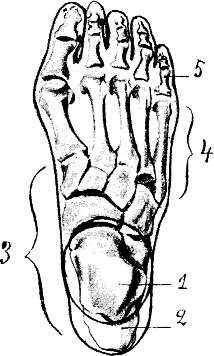Hallux rigidus
Editor-In-Chief: Prab R Tumpati, MD
Obesity, Sleep & Internal medicine
Founder, WikiMD Wellnesspedia &
W8MD medical weight loss NYC and sleep center NYC
| Hallux rigidus | |
|---|---|

| |
| Synonyms | Stiff big toe |
| Pronounce | N/A |
| Specialty | N/A |
| Symptoms | Pain and stiffness in the big toe, difficulty walking |
| Complications | Osteoarthritis |
| Onset | Usually after age 30 |
| Duration | Long-term |
| Types | N/A |
| Causes | Degenerative joint disease, trauma |
| Risks | Family history, foot anatomy, gout |
| Diagnosis | Physical examination, X-ray |
| Differential diagnosis | Gout, bunion, sesamoiditis |
| Prevention | Proper footwear, avoiding foot injuries |
| Treatment | NSAIDs, physical therapy, surgery |
| Medication | NSAIDs |
| Prognosis | Variable, can lead to arthritis |
| Frequency | Common |
| Deaths | N/A |
Hallux rigidus is a medical condition characterized by stiffness and pain in the metatarsophalangeal joint (MTP) of the big toe. It is a form of degenerative arthritis and can significantly impact a person's ability to walk and engage in physical activities.
Signs and Symptoms
The primary symptoms of hallux rigidus include:
- Pain and stiffness in the big toe, especially during walking or standing.
- Swelling and inflammation around the MTP joint.
- Difficulty in bending the big toe.
- Development of bone spurs on the top of the MTP joint, which can lead to a bump that is painful and limits shoe wear.
Causes
Hallux rigidus is often caused by wear and tear of the joint over time. Factors that may contribute to the development of this condition include:
- Osteoarthritis.
- Previous injury to the big toe.
- Abnormal foot anatomy or biomechanics.
- Genetic predisposition.
Diagnosis
Diagnosis of hallux rigidus typically involves:
- A physical examination of the foot.
- X-ray imaging to assess the extent of joint degeneration and the presence of bone spurs.
- Magnetic resonance imaging (MRI) or computed tomography (CT) scans in more complex cases.
Treatment
Treatment options for hallux rigidus vary depending on the severity of the condition and may include:
- Non-surgical treatments:
- Nonsteroidal anti-inflammatory drugs (NSAIDs) to reduce pain and inflammation.
- Physical therapy to improve joint mobility.
- Custom orthotic devices to support the foot and reduce stress on the MTP joint.
- Shoe modifications, such as stiff-soled shoes or shoes with a large toe box.
- Surgical treatments:
- Cheilectomy: Removal of bone spurs and part of the foot bone to improve joint movement.
- Arthrodesis: Fusion of the MTP joint to eliminate pain by preventing joint movement.
- Arthroplasty: Joint replacement surgery to restore function and relieve pain.
Prognosis
The prognosis for individuals with hallux rigidus varies. Non-surgical treatments can often manage symptoms effectively, but in severe cases, surgery may be necessary to restore function and alleviate pain. Early diagnosis and treatment are crucial to prevent the progression of the condition.
Prevention
Preventive measures for hallux rigidus include:
- Wearing appropriate footwear that provides adequate support and room for the toes.
- Avoiding activities that place excessive stress on the big toe.
- Maintaining a healthy weight to reduce pressure on the feet.
- Performing regular foot exercises to maintain joint flexibility and strength.
See Also
References
External Links
Transform your life with W8MD's budget GLP-1 injections from $125.
W8MD offers a medical weight loss program to lose weight in Philadelphia. Our physician-supervised medical weight loss provides:
- Most insurances accepted or discounted self-pay rates. We will obtain insurance prior authorizations if needed.
- Generic GLP1 weight loss injections from $125 for the starting dose.
- Also offer prescription weight loss medications including Phentermine, Qsymia, Diethylpropion, Contrave etc.
NYC weight loss doctor appointments
Start your NYC weight loss journey today at our NYC medical weight loss and Philadelphia medical weight loss clinics.
- Call 718-946-5500 to lose weight in NYC or for medical weight loss in Philadelphia 215-676-2334.
- Tags:NYC medical weight loss, Philadelphia lose weight Zepbound NYC, Budget GLP1 weight loss injections, Wegovy Philadelphia, Wegovy NYC, Philadelphia medical weight loss, Brookly weight loss and Wegovy NYC
|
WikiMD's Wellness Encyclopedia |
| Let Food Be Thy Medicine Medicine Thy Food - Hippocrates |
Medical Disclaimer: WikiMD is not a substitute for professional medical advice. The information on WikiMD is provided as an information resource only, may be incorrect, outdated or misleading, and is not to be used or relied on for any diagnostic or treatment purposes. Please consult your health care provider before making any healthcare decisions or for guidance about a specific medical condition. WikiMD expressly disclaims responsibility, and shall have no liability, for any damages, loss, injury, or liability whatsoever suffered as a result of your reliance on the information contained in this site. By visiting this site you agree to the foregoing terms and conditions, which may from time to time be changed or supplemented by WikiMD. If you do not agree to the foregoing terms and conditions, you should not enter or use this site. See full disclaimer.
Credits:Most images are courtesy of Wikimedia commons, and templates, categories Wikipedia, licensed under CC BY SA or similar.
Contributors: Prab R. Tumpati, MD

